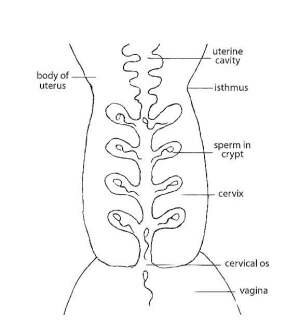The functions of cervical mucus
Cervical mucus is classified under two main headings:
-
gestogenic mucus (G mucus)
-
oestrogenic mucus
G mucus impedes the passage of sperm and oestrogenic mucus encourages sperm motility. The relative amounts of G mucus or oestrogenic mucus in the vagina will determine the state of fertility.
How do the hormones progesterone and oestrogen affect mucus secretion?:
-
Progesterone stimulates the secretion of Gestogenic mucus (G mucus) in the infertile phases of the cycle. G mucus impedes sperm mobility.6 (LINK to 11h for Fig. 11-11)
-
Oestrogen stimulates the secretion of oestrogenic mucus in the fertile phase of the cycle. Oestrogenic mucus encourages sperm mobility and survival. Oestrogenic mucus consists of a mixture of three subtypes L-mucus, S-mucus and P-mucus. P mucus is further subdivided into P2 (also called Pa mucus),2 and P6 mucus.5
Oestrogenic fertile-type mucus has four functions i.e. to filter sperm, to nourish sperm, to transport sperm, to attract sperm. (LINK to 11h)
-
To Filter Sperm3,6 by the action of fertile-type L-mucus. (LINK to 11h for Fig.11-12)
-
To Transport Sperm3,6: fertile-type S-mucus forms swimming lanes to aid the transport of sperm to the crypts. (LINK to 11h for Fig.11-13)
-
To Nourish Sperm: fertile-type S-mucus can keep sperm alive for up to five days as they lie in the cervical crypts. This means that the presence of either the sensation or the appearance of mucus at the vulva is a sign of potential fertility. It is known that sperm die rapidly – perhaps within 30 minutes- in the acid vagina, but may survive up to five days in fertile-type mucus.(1) Fertile-type mucus is alkaline.
-
To Attract Sperm (3): IMPORTANT: Avoid genital contact in the fertile phase of the cycle if pregnancy is to be avoided : Users of natural family planning who wish to avoid pregnancy are advised to avoid all genital contact during the fertile phase for the following reason. It is known that the first portion of the seminal ejaculate has the highest sperm concentration and if there is any genital contact in the fertile-phase of the cycle, fertile-type mucus present at the vulva can attract, and transport sperm to the cervix, and conception may follow without penetration. This statement has been validated by the occurrence of many conceptions without penetration.4

Sperm in the cervical crypts, Fig. 11-10: Longitudinal view of the cervix showing the cervical crypts where the sperm lodge and are nourished awaiting ovulation. Sperm can survive 3-5 days in fertile-type mucus. (LINK to 6e for Fig. 6-16 sperm in genital tract)
Sperm propagation in the cervix:
Spermatozoa enter fertile-type mucus (the S-mucus channels), at the external os of the cervix and swim up the S-mucus channels. A few of them may go directly to the uterine cavity but the majority of the sperm are conveyed to the S crypts.( Fig. 11-10 sperm in crypts). In the S crypts they may ‘hibernate’ for a few hours to some days; the average time is about 20 hours. After a day or so sperm are released from the crypt and begin to propagate and find their way into the uterine cavity in P6 mucus.(2) (LINK to 6e for Fig. 6-16 sperm in genital tract), (LINK to 11h for Fig. 11-13, S mucus).
REFERENCES:
- Klaus, Hanna; ‘Natural family planning – Is it scientific? Is it effective?’; Newman Lecture Series 1 -May 21, 2000. ( internet if you google ‘natural family planning, Dr Hanna Klaus’).
- Odeblad Erik; ‘Cervical mucus and their functions; Journal of the Irish Colleges of Physicians and Surgeons, Jan 1997, Vol 26, No1.; page 28, 29, 30
- Odeblad Erik; ‘The discovery of different types of cervical mucus and the Billings Ovulation Method’ page 10, 11, 14, 15, 18 ; Bull.of the Ovulation Method Research and Reference Centre of Australia, Vol 21, No3; 3-35; Sept 1994. (google bErik Odeblad, cervical mucus’.)
- Klaus, H ; Natural Family Planning : A Review 2nd Edition. July 1995, page 13; NFP Center of Washington, D.C. Inc. , 8514 Bradmoor Drive, Bethesda, MD 20817-3810.
- Vigil P, Ceric F, Cortes M, Klaus H; ‘Usefulness of monitoring fertility from menarche; J Pediatr Adolesc Gynecol (2006), 19: 173-179
- Hanson FW, Overstreet JW; ‘The interaction of human spermatozoa with cervical mucus in vivo’; Am J Obstet Gynecol 140;173;1981
To be most effective, the woman must be taught the Symptothermal Double-Check Method of Natural Family Planning by a qualified natural family planning teacher.

